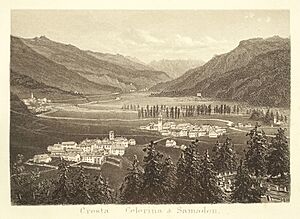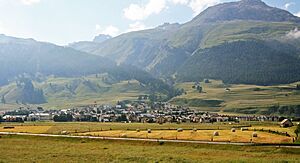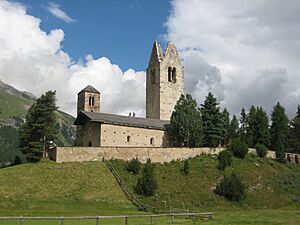Celerina/Schlarigna facts for kids
Quick facts for kids
Celerina/Schlarigna
|
||
|---|---|---|
 |
||
|
||
| Country | Switzerland | |
| Canton | Graubünden | |
| District | Maloja | |
| Area | ||
| • Total | 24.02 km2 (9.27 sq mi) | |
| Elevation | 1,714 m (5,623 ft) | |
| Population
(Dec 2020 )
|
||
| • Total | 1,484 | |
| • Density | 61.78/km2 (160.01/sq mi) | |
| Postal code |
7505
|
|
| Surrounded by | Pontresina, Samedan, Sankt-Moritz | |
Celerina/Schlarigna is a lovely village in the Maloja Region of Switzerland. It is located in the canton of Graubünden. You might hear its name in German or Italian as Celerina, or in Romansh. It's a popular spot for both summer and winter fun!
Contents
History of Celerina/Schlarigna
Celerina/Schlarigna was first written about in the year 1313. Back then, it was called Schellarin. Later, in 1320, it was known as Celarina.
A big fire in 1631 sadly destroyed 43 houses in the village. But Celerina grew and changed over time. From the 1860s, more and more visitors started coming. This was the beginning of tourism in the area.
Some famous sports tracks opened here:
- The Cresta Run for tobogganing started in 1884.
- The St. Moritz-Celerina Olympic Bobrun for bobsledding opened in 1904.
- A cable car to Saluver was built in 1958, making it easier to reach the mountains.
Originally, Celerina was a farming village where people spoke Romansh. But as tourism grew, many people moved here from German-speaking parts of Switzerland and even from Italy. This changed the village a lot!
Geography of Celerina/Schlarigna
Celerina/Schlarigna covers an area of about 24 square kilometers (9.3 square miles). A big part of this land, about 34%, is used for farming. Forests cover another 30.5% of the area. About 4.1% of the land has buildings or roads. The rest, 31.4%, is made up of rivers, glaciers, or mountains.
The village of Celerina/Schlarigna is a haufendorf. This means it's an old, unplanned village with houses built close together around a central area. It also includes a smaller settlement called Crasta.
The village is in the upper part of the Engadin valley. It sits between the towns of St. Moritz, Samedan, and Pontresina. The famous Cresta Run for tobogganing, which starts in St. Moritz, actually finishes in the Cresta area of Celerina.
Population and People
Celerina/Schlarigna has a population of about 1,500 people. Around 31.8% of the people living here are from other countries. Over the last 10 years, the number of people living in Celerina has grown by about 13.7%.
In 2000, the population was almost evenly split between males (48.4%) and females (51.6%).
- About 11.2% of the population were children aged 0 to 9 years old.
- Teenagers aged 10 to 19 made up about 10.8% of the population.
- Adults aged 20 to 59 made up about 65.4% of the population.
- Older adults aged 60 to 99 made up about 12.5% of the population.
Most people in Switzerland are well-educated. In Celerina/Schlarigna, about 69.9% of adults (aged 25-64) have finished high school or gone on to higher education, like university.
The unemployment rate in Celerina/Schlarigna is quite low, at 1.47%. This means most people who want to work can find jobs.
- A small number of people (20) work in farming.
- More people (153) work in manufacturing and construction.
- The largest number of people (564) work in services, like tourism, shops, and restaurants.
Here's how the population has changed over many years:
| year | population |
|---|---|
| 1850 | 245 |
| 1900 | 341 |
| 1950 | 713 |
| 1960 | 868 |
| 1970 | 983 |
| 1980 | 890 |
| 1990 | 975 |
| 2000 | 1,353 |
Languages Spoken
Most people in Celerina/Schlarigna speak German. In 2000, about 58.3% of the population spoke German. Italian was the second most common language (19.3%), and Romansh was third (12.8%).
For a long time, until the mid-1800s, almost everyone in Celerina spoke Romansh. But as the village became more connected to the outside world, fewer people spoke Romansh.
- In 1860, about 96% of people spoke Romansh as their main language.
- By 1900, this number dropped to 68%.
- The last time Romansh was the main language in Celerina/Schlarigna was in 1941.
- After World War II, German became the most common language.
Even though fewer people speak Romansh as their first language now, many still understand it. In 2000, about 35% of the population could understand Romansh.
Here is a table showing how the languages have changed over time:
| Languages | Census 1980 | Census 1990 | Census 2000 | |||
|---|---|---|---|---|---|---|
| Number | Percent | Number | Percent | Number | Percent | |
| German | 390 | 43.82% | 535 | 54.87% | 789 | 58.31% |
| Romansh | 273 | 30.67% | 198 | 20.31% | 173 | 12.79% |
| Italian | 178 | 20.00% | 176 | 18.05% | 261 | 19.29% |
| Population | 890 | 100% | 975 | 100% | 1353 | 100% |
Important Historic Sites
The Swiss Reformed Church of San Gian is a very important historical building in Switzerland. It is located on a hill above the Inn River.
The church you see today was built in 1478. But before that, there was a chapel on the same spot that was about 500 years older! The church has a special painted wooden roof and beautiful wall paintings called frescoes. In 1682, lightning struck the large bell tower. The top of the tower burned, and it was never rebuilt.
Tourism in Celerina/Schlarigna

Celerina/Schlarigna is in a wide part of the Engadin valley, which means it gets a lot of sunshine! It's known as the sunniest spot in the upper Engadin valley.
Unlike its more famous neighbor, St. Moritz, Celerina has kept many of its old buildings in the town center. Many of these buildings are from the 1600s. The town has three historic churches:
- A small Romanesque church in Cresta.
- The Gothic church of San Gian, which is very old.
- The beautiful Baroque-style Bel Taimpel church, built in 1669, in the heart of the village.
Celerina used to be a farming village, but now tourism is very important. There aren't many huge hotels, but there are many smaller hotels and inns. Many visitors also stay in vacation apartments, which are homes owned by people who use them for holidays or rent them out.
Celerina is popular for both summer and winter holidays.
- Summer activities include hiking and mountaineering in the beautiful mountains. Mountain biking has also become very popular. Nearby, you can also enjoy golf, glider flying, swimming, and hang-gliding.
- Winter activities are very popular. You can enjoy both Nordic (cross-country) and alpine (downhill) skiing. You can also try exciting sports like bobsleigh and skeleton on the famous Cresta Run, which finishes in Celerina. There's a direct gondola lift from Celerina that takes skiers right into the main ski area of Corviglia/Marguns, which is part of St. Moritz.
Getting Around: Transportation
Celerina/Schlarigna has three train stations: Celerina, Celerina Staz, and Punt Muragl Staz. All these stations are on lines of the Rhaetian Railway. This means you can easily travel by train to places like St. Moritz, Chur, Landquart, and Tirano.
See also
 In Spanish: Celerina/Schlarigna para niños
In Spanish: Celerina/Schlarigna para niños








